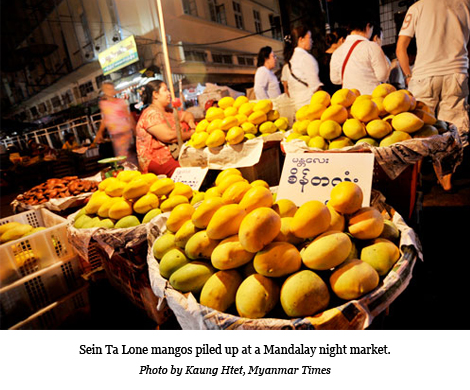by Kyae Mone Win and translated by Thiri Min Htun, Myanmar Times
Trademark protection is in the works for Myanmar’s famous sein ta lone [diamond] mangos, according to Mandalay Mango Association chair Daw Than Than Swe.
 The fruit has been exported since 2006, but only began catching on in foreign markets around 2011. Sein ta lone mangos are growing in popularity overseas – one food reviewer from The Straits Times said they “seem to be all the rage” in Singapore earlier this year, while they are also exported in increasingly large quantities to China.
The fruit has been exported since 2006, but only began catching on in foreign markets around 2011. Sein ta lone mangos are growing in popularity overseas – one food reviewer from The Straits Times said they “seem to be all the rage” in Singapore earlier this year, while they are also exported in increasingly large quantities to China.
Growing international awareness of the fruit is boosting local exports, but also increasing the risk that a foreign competitor could claim Sein ta lone mangos as their own.
“There is an urgent need to register Myanmar Sein ta lone mangos,” said one trader. “If not, other countries with more money will seek to register it as their own mango.”
The Korea Invention Promotion Agency and Myanmar’s Ministry of Science and Technology and the Myanmar Fruits, Flowers and Vegetables Association will assist with the process. It will be expensive, but South Korea is covering some of the costs and also suggesting how to establish the trademark and promote the fruit.
“It is necessary to take the time to register Myanmar’s mangos, and there are many things we have to do,” said Daw Than Than Swe, chair of the Mandalay Mango Association.
The mango association is working to boost mango exports and generate more revenue through adding value to products. There are more than 200 mango species in Myanmar, with 50 to 60 species grown in Mandalay Region.
A number of other mangos are also being considered for trademark protection, including shwe hin thar, padamyar nga mauk, yin kwe and ma chit su fruits.
In most countries, mangos would likely be protected by geographical indication status. This status for instance requires wine using the “champagne” label to be from certain areas of France or “Scotch whisky” from Scotland. However, Myanmar’s trademark laws – widely considered to be outdated – do not provide for geographical indication protection, meaning the mangos are likely to be protected under the existing trademark protections.
U Aung Soe Oo, councillor at the Asean Intellectual Property Association, said the government should implement a system to protect goods such as the mangos, otherwise risk losing its intellectual property to other countries.
However, protecting Sein ta lone mangos through trademark will likely not provide the comprehensive protection that could be afforded by geographical indicator status, he added.
There have been ongoing discussions to update the existing intellectual property laws, though so far no law has been passed. The 1908 Registration Act allows companies to register trademarks through evidentiary assertion of the rights of ownership, though there is no trademark law at present, according to the World Intellectual Property Organisation.
Source: Myanmar Times
